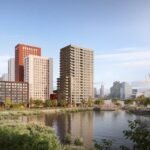Now Reading: Iconic Bridges and Roads That Influence Property Demand
-
01
Iconic Bridges and Roads That Influence Property Demand
Iconic Bridges and Roads That Influence Property Demand

Real estate demand often depends on location, accessibility, and infrastructure. Among the most powerful drivers of property values are iconic bridges and roads. These structures do far more than connect cities and towns they reshape neighborhoods, attract businesses, and influence where people want to live or invest. From the Brooklyn Bridge in New York to the Bandra-Worli Sea Link in Mumbai, iconic bridges and roads leave a lasting mark on property demand worldwide.
This article explores how these engineering marvels influence property markets, why investors closely follow transport projects, and which famous examples showcase this global trend.
Why Iconic Bridges and Roads Matter in Real Estate
Infrastructure is the backbone of urban growth. Without efficient transport links, even the most promising neighborhoods struggle to attract residents and investors. Iconic bridges and roads matter because:
- Improved Accessibility: They reduce travel time and make areas more convenient to live in.
- Economic Growth: Businesses flock to locations with strong connectivity.
- Tourism Boost: Iconic structures become attractions, increasing demand for nearby hotels and rentals.
- Urban Expansion: Roads and bridges often open up new zones for housing and commercial projects.
- Emotional Value: Iconic structures add prestige, making properties near them more desirable.
For developers, the announcement of a new bridge or expressway often signals a surge in property prices long before the project is completed.
Historical Examples of Iconic Bridges Shaping Cities
Brooklyn Bridge, New York City
When the Brooklyn Bridge opened in 1883, it transformed New York City forever. Suddenly, Brooklyn was no longer just a separate borough it was an integral part of Manhattan’s growth story. Property prices around Brooklyn Heights and Dumbo surged as accessibility improved. Today, luxury apartments overlooking the bridge command some of the highest rents in the city.
Tower Bridge, London
Built in 1894, Tower Bridge not only connected parts of London but also became a global landmark. Areas near the bridge, like South Bank, saw steady appreciation in property values over decades. Today, riverside apartments with direct views of Tower Bridge are among the most expensive in London.
Golden Gate Bridge, San Francisco
The Golden Gate Bridge, completed in 1937, opened up Marin County to San Francisco commuters. This not only boosted suburban housing demand but also gave rise to luxury estates in Sausalito and surrounding areas. The bridge remains both a tourist attraction and a property value driver.
Modern Bridges Driving Property Demand
Bandra-Worli Sea Link, Mumbai
The Bandra-Worli Sea Link drastically cut travel time between South Mumbai and its northern suburbs. Before its construction, long commutes discouraged many from living farther from the city center. After the sea link opened in 2009, real estate demand surged in Worli, Bandra, and adjoining areas, with prices appreciating faster than the Mumbai average.
Øresund Bridge, Denmark-Sweden
This 8-kilometer marvel connects Copenhagen (Denmark) with Malmö (Sweden). Completed in 2000, it boosted cross-border commuting and tourism. As a result, Malmö saw a surge in property development, with international investors entering the Swedish housing market thanks to its newfound accessibility.
Sheikh Zayed Bridge, Abu Dhabi
Designed by Zaha Hadid, this striking bridge has become a symbol of Abu Dhabi’s modernization. By improving connectivity to the city’s mainland, it unlocked new areas for urban development, increasing property demand in neighborhoods like Al Maqtaa and surrounding districts.
Roads That Transformed Real Estate
While bridges capture the imagination, roads are equally powerful in reshaping property markets. Expressways and highways expand cities, making once-remote locations desirable.
Yamuna Expressway, India
Connecting Delhi to Agra, the Yamuna Expressway transformed entire regions along its route. Townships, industrial hubs, and educational institutions flourished, and real estate investors rushed to secure land near this modern highway.
Pacific Coast Highway, California
This scenic coastal route doesn’t just provide breathtaking views it boosts property demand in towns like Malibu, Laguna Beach, and Big Sur. Beachfront properties along the Pacific Coast Highway command some of the highest prices in the U.S.
Autobahn, Germany
Germany’s world-famous Autobahn created rapid suburbanization, allowing people to live farther from major cities while still enjoying convenient access. Properties near major Autobahn exits remain highly sought after by both residents and businesses.
How Bridges and Roads Influence Property Prices

The impact of iconic bridges and roads on real estate can be seen in several key ways:
- Price Appreciation Before Completion
Real estate prices often begin rising as soon as a major bridge or road project is announced. Investors anticipate future growth and rush to secure land early. - Luxury Developments Near Iconic Landmarks
Properties with direct views of iconic bridges, like the Brooklyn Bridge or Tower Bridge, command a premium. Scenic value and prestige drive higher demand. - Commercial Growth Along Expressways
Roads like the Yamuna Expressway attract industries, logistics companies, and retail outlets. This boosts demand for both residential and commercial spaces nearby. - Tourism-Driven Rentals
Areas near iconic bridges often see strong demand for short-term rentals from tourists, creating a robust hospitality-driven property market.
Case Study: Property Boom Near the Sydney Harbour Bridge
The Sydney Harbour Bridge, completed in 1932, not only became an Australian icon but also transformed real estate demand in Sydney. Neighborhoods like Kirribilli, North Sydney, and Milsons Point became highly desirable thanks to their proximity to the bridge. Today, these areas command some of the highest property prices in Australia, largely because of the bridge’s role in linking the city’s north and south.
Investment Opportunities Around Upcoming Projects
Real estate investors closely track upcoming bridges and roads to spot early opportunities. Some projects attracting global attention include:
- Fehmarnbelt Tunnel (Denmark-Germany): Expected to boost cross-border trade and property demand in both countries.
- Mumbai Trans Harbour Link (India): Set to connect Mumbai with Navi Mumbai, unlocking huge real estate potential.
- New Hudson River Tunnel (USA): Will enhance New Jersey-New York connectivity, with ripple effects on property values in nearby areas.
These upcoming projects highlight how infrastructure investment continues to shape property markets worldwide.
Challenges and Considerations
While bridges and roads often drive property demand, investors should remain aware of challenges:
- Over-Speculation: Prices may inflate too quickly before projects are completed.
- Environmental Concerns: Some projects face opposition due to ecological impact.
- Unequal Growth: Not all areas benefit equally—some neighborhoods thrive, while others stagnate.
- Maintenance and Traffic Issues: If infrastructure isn’t well-maintained, property values can suffer in the long run.
Future Outlook: Smart Roads and Sustainable Bridges
As cities grow smarter and more eco-conscious, the next generation of bridges and roads will focus on sustainability and technology. Green bridges, solar-powered highways, and smart toll systems will not only improve efficiency but also attract environmentally aware investors.
Cities that successfully integrate sustainable infrastructure will likely see even stronger property demand, as modern buyers increasingly value eco-friendly urban living.
Conclusion
Iconic bridges and roads are far more than engineering achievements—they are catalysts of real estate transformation. From the Brooklyn Bridge in New York to the Bandra-Worli Sea Link in Mumbai, these structures redefine accessibility, prestige, and property values.
For homebuyers and investors, keeping an eye on major infrastructure projects is often the key to spotting the next real estate hotspot. As cities worldwide continue to expand and modernize, iconic bridges and roads will remain powerful forces shaping property demand for decades to come.
Follow us on: Instagram






















